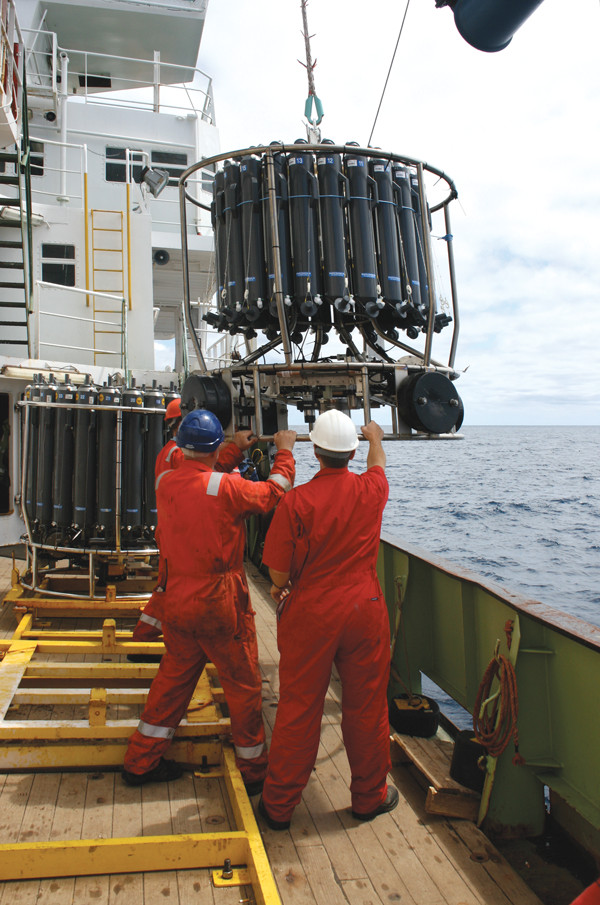
by Timothy Oleson Friday, August 8, 2014

Technicians aboard the British RRS James Cook retrieve a seawater sampling device in the Southern Ocean. Credit: Gideon Henderson.
Ash plumes from volcanoes in South America and elsewhere may spur large blooms of plankton in otherwise barren parts of the Southern Ocean, but maybe not for the reason scientists have suspected, according to a new study. Such blooms are of interest because they consume atmospheric carbon dioxide, although their overall effect on climate remains far from clear.
The frigid waters of the Drake Passage between South America and Antarctica contain enough macronutrients like nitrate and phosphate to support large communities of surface-dwelling plankton. Yet plankton populations there remain small because of low levels of micronutrients needed in small but critical doses. Iron deficiency, in particular, has been thought to play a key role in suppressing the microorganisms. And fertilization experiments — carried out at sea and in the lab — using dissolved iron and aimed at seeding plankton growth and quantifying carbon uptake from the atmosphere have shown that doses of the element can stimulate growth.
While aboard research cruises in 2012, scientists interested in whether volcanic plumes blown out over the ocean might also stimulate blooms — a long-theorized but little-studied hypothesis — bottled seawater samples from locations in the South Atlantic and the Drake Passage. To each sample, they added either dissolved iron alone or portions of natural volcanic ash: either a basaltic ash collected from a 2002 eruption of Italy’s Mount Etna, or a rhyolitic ash from a 2008 eruption of Chaitén in the Chilean Andes. After one to two days, they analyzed the bottles' contents to see how concentrations of various dissolved nutrients, as well as the pigment chlorophyll, a proxy for phytoplankton population, had changed.
In water samples taken from the Drake Passage, an area with some of the lowest levels of chlorophyll in the Southern Ocean, “we found very little response to the addition of iron only, yet marked [and similar] responses when we added the two different ash types,” says Thomas Browning, a doctoral student at the University of Oxford in England and lead author of the study, which was published in Geophysical Research Letters.
In some cases, chlorophyll levels increased twice as much with the ash compared to just iron. “It’s typically assumed that these phytoplankton are iron-limited,” Browning says, so the results were unexpected. The results also suggested that something in the ash other than iron, or possibly in conjunction with iron, was spurring phytoplankton growth.
The likely candidate, suggest Browning and his colleagues, is manganese, an integral element in certain cellular functions. Concentrations of the trace metal in the Drake Passage measured by the researchers were among the lowest ever recorded in seawater. And, in separate experiments, they observed similar amounts of manganese dissolving from the two types of ash, whereas far more iron dissolved from the basaltic ash than from the rhyolitic ash, again suggesting that iron was not the biggest limiting factor.
Manganese limitation on marine phytoplankton has been suggested before by other researchers, including by Rob Middag, a marine chemist at the University of Otago in New Zealand who wasn’t involved in the new study. But, Middag says, this is “the first convincing, direct evidence” of such an effect. He calls the study noteworthy and says it highlights that scientists are “slowly migrating” away from the notion that iron is always the most important trace element for phytoplankton.
What the most critical or limiting nutrients are in the ocean likely depends on various factors, Middag says. “Location plays a role, timing plays a role, and the phytoplankton community plays a role.”
More experiments are needed to demonstrate conclusively manganese limitation — or co-limitation with iron — on phytoplankton in this area, Browning says, but “it’s quite significant” if it’s real. “This could control productivity and, consequently, carbon dioxide sequestration over long timescales,” which means “we need to better understand the fluxes of both manganese and iron into the Southern Ocean,” he says.
When volcanic eruptions occur, “you can see the ash plumes going over the Southern Ocean” in satellite imagery, Browning says. And “there are records of past eruptions that have almost certainly deposited large amounts of the same ash types [as those tested] into these waters.” Combined with those observations, he says, “the results from this work suggest that they will produce fertilization in some areas of the ocean.”
Eruptions surely contribute to blooms when they happen, “but it’s hard to estimate the overall importance of ash fertilization because eruptions are so erratic,” Middag notes. “You never know when one is going to come and where it’s going to happen.”
Browning agrees, adding that the amount of carbon extracted from the atmosphere due to volcanic ash fertilization “is a really big unknown.”
© 2008-2021. All rights reserved. Any copying, redistribution or retransmission of any of the contents of this service without the expressed written permission of the American Geosciences Institute is expressly prohibited. Click here for all copyright requests.